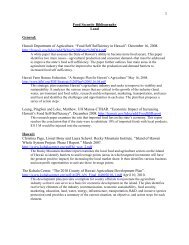Report on the State of Physical Infrastructure in Hawaii
Report on the State of Physical Infrastructure in Hawaii
Report on the State of Physical Infrastructure in Hawaii
You also want an ePaper? Increase the reach of your titles
YUMPU automatically turns print PDFs into web optimized ePapers that Google loves.
Unlike many o<strong>the</strong>r areas where a shift <strong>in</strong> tect<strong>on</strong>ic plates is <strong>the</strong> sole cause<strong>of</strong> an earthquake, 95 percent <strong>of</strong> <strong>the</strong> earthquakes <strong>in</strong> <strong>Hawaii</strong> are l<strong>in</strong>ked tovolcanic activity. These earthquakes can occur before or dur<strong>in</strong>g erupti<strong>on</strong>s,or as magma (molten rock) travels underground. The earthquakesdirectly associated with <strong>the</strong> movement <strong>of</strong> magma are c<strong>on</strong>centrated <strong>on</strong> <strong>the</strong>sou<strong>the</strong>rn part <strong>of</strong> <strong>the</strong> island <strong>of</strong> <strong>Hawaii</strong> and al<strong>on</strong>g its K<strong>on</strong>a coast beneathtwo <strong>of</strong> <strong>the</strong> island’s active volcanoes, Kilauea and Mauna Loa. Kilauea is<strong>on</strong>e <strong>of</strong> <strong>the</strong> world’s most active volcanoes and most <strong>of</strong> <strong>the</strong> earthquakes areassociated with <strong>in</strong>cremental movement <strong>of</strong> <strong>the</strong> volcano’s flank towards<strong>the</strong> sea. A few <strong>of</strong> <strong>the</strong> island’s earthquakes are less directly related tovolcanism; <strong>the</strong>se earthquakes orig<strong>in</strong>ate <strong>in</strong> z<strong>on</strong>es <strong>of</strong> structural weakness at<strong>the</strong> base <strong>of</strong> <strong>the</strong> volcanoes or deep with<strong>in</strong> <strong>the</strong> earth beneath <strong>the</strong> islands.S<strong>in</strong>ce 1952 <strong>the</strong>re have been 34 erupti<strong>on</strong>s, and eruptive activity hasbeen c<strong>on</strong>t<strong>in</strong>uous al<strong>on</strong>g Kilauea’s east rift z<strong>on</strong>e s<strong>in</strong>ce January 1983. Veryshallow earthquakes frequently precede or accompany an erupti<strong>on</strong>.Hundreds <strong>of</strong> such earthquakes make up swarms that comm<strong>on</strong>ly occurover a period <strong>of</strong> several hours or days before an erupti<strong>on</strong> as magma forcesits way <strong>in</strong>to a new area. These earthquakes are seldom large enoughto cause widespread damage, but <strong>the</strong>y may produce extensive groundfractur<strong>in</strong>g close to <strong>the</strong> potential erupti<strong>on</strong> site. Once an erupti<strong>on</strong> beg<strong>in</strong>s,<strong>the</strong> earthquakes usually dim<strong>in</strong>ish.The most recent and significant earthquake <strong>in</strong> <strong>the</strong> state occurred <strong>of</strong>f <strong>the</strong>northwest coast <strong>of</strong> Kiholo, <strong>Hawaii</strong> <strong>in</strong> October 2006. Categorized as a 6.7magnitude event, <strong>the</strong> costs for repair and restorati<strong>on</strong> <strong>of</strong> critical <strong>in</strong>frastructurefollow<strong>in</strong>g <strong>the</strong> Kiholo Bay Earthquake are $100 milli<strong>on</strong>. Estimateddamage to <strong>in</strong>frastructure for <strong>the</strong> same event is more than $120 milli<strong>on</strong>.Eng<strong>in</strong>eers, seismologists, architects, and planners have carefully evaluatedseismic hazards related to build<strong>in</strong>g c<strong>on</strong>structi<strong>on</strong>. They have devised asystem <strong>of</strong> classify<strong>in</strong>g seismic hazards <strong>on</strong> <strong>the</strong> basis <strong>of</strong> <strong>the</strong> expected strength<strong>of</strong> ground shak<strong>in</strong>g and <strong>the</strong> probability <strong>of</strong> <strong>the</strong> shak<strong>in</strong>g actually occurr<strong>in</strong>gwith<strong>in</strong> a specified time. The results are <strong>in</strong>cluded <strong>in</strong> <strong>the</strong> Uniform Build<strong>in</strong>gCode (UBC) seismic provisi<strong>on</strong>s.The UBC seismic provisi<strong>on</strong>s c<strong>on</strong>ta<strong>in</strong> six seismic z<strong>on</strong>es, rang<strong>in</strong>g from 0(no chance <strong>of</strong> severe ground shak<strong>in</strong>g) to 4 (10 percent chance <strong>of</strong> severeshak<strong>in</strong>g <strong>in</strong> a 50-year <strong>in</strong>terval). The shak<strong>in</strong>g is quantified <strong>in</strong> terms <strong>of</strong>g-force, <strong>the</strong> earth’s gravitati<strong>on</strong>al accelerati<strong>on</strong>. The diagrams <strong>on</strong> <strong>the</strong>follow<strong>in</strong>g page depict seismic z<strong>on</strong>ati<strong>on</strong>.14







